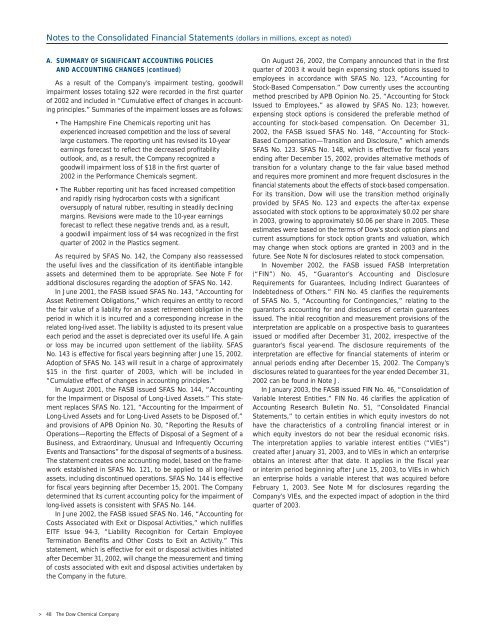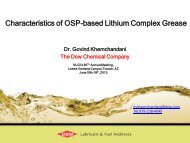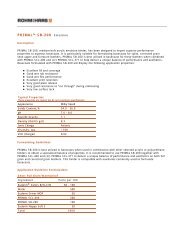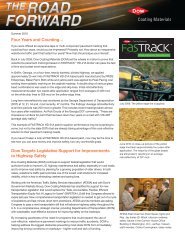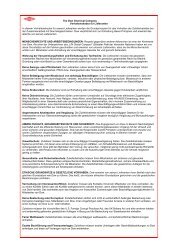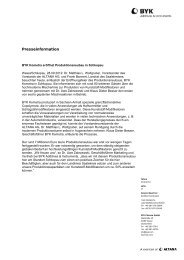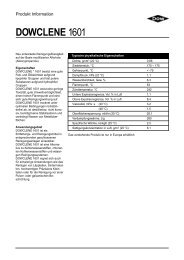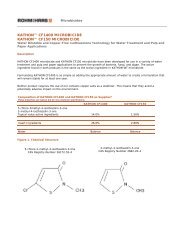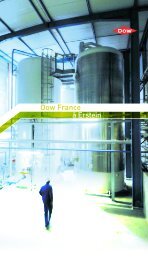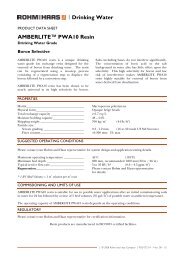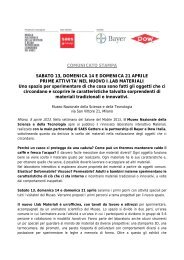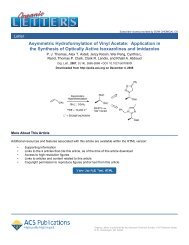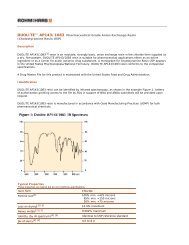Focus - The Dow Chemical Company
Focus - The Dow Chemical Company
Focus - The Dow Chemical Company
Create successful ePaper yourself
Turn your PDF publications into a flip-book with our unique Google optimized e-Paper software.
Notes to the Consolidated Financial Statements (dollars in millions, except as noted)<br />
A. SUMMARY OF SIGNIFICANT ACCOUNTING POLICIES<br />
AND ACCOUNTING CHANGES (continued)<br />
As a result of the <strong>Company</strong>’s impairment testing, goodwill<br />
impairment losses totaling $22 were recorded in the first quarter<br />
of 2002 and included in “Cumulative effect of changes in accounting<br />
principles.” Summaries of the impairment losses are as follows:<br />
• <strong>The</strong> Hampshire Fine <strong>Chemical</strong>s reporting unit has<br />
experienced increased competition and the loss of several<br />
large customers. <strong>The</strong> reporting unit has revised its 10-year<br />
earnings forecast to reflect the decreased profitability<br />
outlook, and, as a result, the <strong>Company</strong> recognized a<br />
goodwill impairment loss of $18 in the first quarter of<br />
2002 in the Performance <strong>Chemical</strong>s segment.<br />
• <strong>The</strong> Rubber reporting unit has faced increased competition<br />
and rapidly rising hydrocarbon costs with a significant<br />
oversupply of natural rubber, resulting in steadily declining<br />
margins. Revisions were made to the 10-year earnings<br />
forecast to reflect these negative trends and, as a result,<br />
a goodwill impairment loss of $4 was recognized in the first<br />
quarter of 2002 in the Plastics segment.<br />
As required by SFAS No. 142, the <strong>Company</strong> also reassessed<br />
the useful lives and the classification of its identifiable intangible<br />
assets and determined them to be appropriate. See Note F for<br />
additional disclosures regarding the adoption of SFAS No. 142.<br />
In June 2001, the FASB issued SFAS No. 143, “Accounting for<br />
Asset Retirement Obligations,” which requires an entity to record<br />
the fair value of a liability for an asset retirement obligation in the<br />
period in which it is incurred and a corresponding increase in the<br />
related long-lived asset. <strong>The</strong> liability is adjusted to its present value<br />
each period and the asset is depreciated over its useful life. A gain<br />
or loss may be incurred upon settlement of the liability. SFAS<br />
No. 143 is effective for fiscal years beginning after June 15, 2002.<br />
Adoption of SFAS No. 143 will result in a charge of approximately<br />
$15 in the first quarter of 2003, which will be included in<br />
“Cumulative effect of changes in accounting principles.”<br />
In August 2001, the FASB issued SFAS No. 144, “Accounting<br />
for the Impairment or Disposal of Long-Lived Assets.” This statement<br />
replaces SFAS No. 121, “Accounting for the Impairment of<br />
Long-Lived Assets and for Long-Lived Assets to be Disposed of,”<br />
and provisions of APB Opinion No. 30, “Reporting the Results of<br />
Operations—Reporting the Effects of Disposal of a Segment of a<br />
Business, and Extraordinary, Unusual and Infrequently Occurring<br />
Events and Transactions” for the disposal of segments of a business.<br />
<strong>The</strong> statement creates one accounting model, based on the framework<br />
established in SFAS No. 121, to be applied to all long-lived<br />
assets, including discontinued operations. SFAS No. 144 is effective<br />
for fiscal years beginning after December 15, 2001. <strong>The</strong> <strong>Company</strong><br />
determined that its current accounting policy for the impairment of<br />
long-lived assets is consistent with SFAS No. 144.<br />
In June 2002, the FASB issued SFAS No. 146, “Accounting for<br />
Costs Associated with Exit or Disposal Activities,” which nullifies<br />
EITF Issue 94-3, “Liability Recognition for Certain Employee<br />
Termination Benefits and Other Costs to Exit an Activity.” This<br />
statement, which is effective for exit or disposal activities initiated<br />
after December 31, 2002, will change the measurement and timing<br />
of costs associated with exit and disposal activities undertaken by<br />
the <strong>Company</strong> in the future.<br />
> 48 <strong>The</strong> <strong>Dow</strong> <strong>Chemical</strong> <strong>Company</strong><br />
On August 26, 2002, the <strong>Company</strong> announced that in the first<br />
quarter of 2003 it would begin expensing stock options issued to<br />
employees in accordance with SFAS No. 123, “Accounting for<br />
Stock-Based Compensation.” <strong>Dow</strong> currently uses the accounting<br />
method prescribed by APB Opinion No. 25, “Accounting for Stock<br />
Issued to Employees,” as allowed by SFAS No. 123; however,<br />
expensing stock options is considered the preferable method of<br />
accounting for stock-based compensation. On December 31,<br />
2002, the FASB issued SFAS No. 148, “Accounting for Stock-<br />
Based Compensation—Transition and Disclosure,” which amends<br />
SFAS No. 123. SFAS No. 148, which is effective for fiscal years<br />
ending after December 15, 2002, provides alternative methods of<br />
transition for a voluntary change to the fair value based method<br />
and requires more prominent and more frequent disclosures in the<br />
financial statements about the effects of stock-based compensation.<br />
For its transition, <strong>Dow</strong> will use the transition method originally<br />
provided by SFAS No. 123 and expects the after-tax expense<br />
associated with stock options to be approximately $0.02 per share<br />
in 2003, growing to approximately $0.06 per share in 2005. <strong>The</strong>se<br />
estimates were based on the terms of <strong>Dow</strong>’s stock option plans and<br />
current assumptions for stock option grants and valuation, which<br />
may change when stock options are granted in 2003 and in the<br />
future. See Note N for disclosures related to stock compensation.<br />
In November 2002, the FASB issued FASB Interpretation<br />
(“FIN”) No. 45, “Guarantor’s Accounting and Disclosure<br />
Requirements for Guarantees, Including Indirect Guarantees of<br />
Indebtedness of Others.” FIN No. 45 clarifies the requirements<br />
of SFAS No. 5, “Accounting for Contingencies,” relating to the<br />
guarantor’s accounting for and disclosures of certain guarantees<br />
issued. <strong>The</strong> initial recognition and measurement provisions of the<br />
interpretation are applicable on a prospective basis to guarantees<br />
issued or modified after December 31, 2002, irrespective of the<br />
guarantor’s fiscal year-end. <strong>The</strong> disclosure requirements of the<br />
interpretation are effective for financial statements of interim or<br />
annual periods ending after December 15, 2002. <strong>The</strong> <strong>Company</strong>’s<br />
disclosures related to guarantees for the year ended December 31,<br />
2002 can be found in Note J.<br />
In January 2003, the FASB issued FIN No. 46, “Consolidation of<br />
Variable Interest Entities.” FIN No. 46 clarifies the application of<br />
Accounting Research Bulletin No. 51, “Consolidated Financial<br />
Statements,” to certain entities in which equity investors do not<br />
have the characteristics of a controlling financial interest or in<br />
which equity investors do not bear the residual economic risks.<br />
<strong>The</strong> interpretation applies to variable interest entities (“VIEs”)<br />
created after January 31, 2003, and to VIEs in which an enterprise<br />
obtains an interest after that date. It applies in the fiscal year<br />
or interim period beginning after June 15, 2003, to VIEs in which<br />
an enterprise holds a variable interest that was acquired before<br />
February 1, 2003. See Note M for disclosures regarding the<br />
<strong>Company</strong>’s VIEs, and the expected impact of adoption in the third<br />
quarter of 2003.


